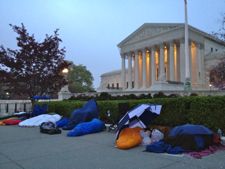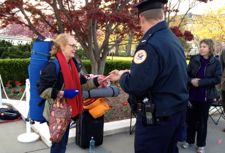
I wanted to see the Supreme Court's health care arguments with my own two eyes because my family has a lot riding on the outcome. My kids are sick with incurable illnesses and are uninsurable in the private insurance market. Obamacare will fix that in 2014 if the law survives the constitutional challenge.
When the Court declined requests for television coverage, I had no option but to travel from my Atlanta home to Washington, D.C. to join the queue for one of the 50 or so seats available to the public. All other average Americans would have to depend on media reports or audiotapes and transcripts released after the arguments.
 I began my epic 92-hour urban camp-out on the sidewalk in front of the Supreme Court on Friday afternoon. Tents are not allowed, so I assembled a borrowed folding chair, a plastic tarp, and a sleeping bag from Target to protect me from the elements.
I began my epic 92-hour urban camp-out on the sidewalk in front of the Supreme Court on Friday afternoon. Tents are not allowed, so I assembled a borrowed folding chair, a plastic tarp, and a sleeping bag from Target to protect me from the elements.
Chair-camping is particularly challenging, especially in bad weather. I speak from experience when I tell you that a tarp bungeed to a pop-up chair will not protect you from pouring rain, bitter cold and wind. When the tarp blew off my chair before dawn Tuesday morning with the temperature below freezing, I wondered if I would survive until morning.
 Many of my line-mates were uninsured homeless men being paid a pittance to hold seats for wealthy VIPs. Some fared much worse than me during Saturday night's downpour because their supervisor had failed to deliver tarps and umbrellas as promised.
Many of my line-mates were uninsured homeless men being paid a pittance to hold seats for wealthy VIPs. Some fared much worse than me during Saturday night's downpour because their supervisor had failed to deliver tarps and umbrellas as promised.
My suffering paid off when I was first in the public line for Tuesday's arguments on the individual mandate. I climbed the stairs into the court's marble palace towing my camping gear wearing the same clothes I'd slept in for several nights.
A different world awaited me inside. Americans at home listening to audiotapes would not witness the scene inside the velvet-lined chamber where an audience of Senators, Congressmen, and Washington elites -- each one hand-selected by the court -- milled about.
 There is no way average citizens listening later could fully appreciate the dramatic interplay between the justices seated on their stage as they peppered the advocates with carefully posed questions and practiced soliloquies. Transcripts and audiotapes would not describe Justice Breyer waiving the 2,700 page statute or Justice Alito dozing.
There is no way average citizens listening later could fully appreciate the dramatic interplay between the justices seated on their stage as they peppered the advocates with carefully posed questions and practiced soliloquies. Transcripts and audiotapes would not describe Justice Breyer waiving the 2,700 page statute or Justice Alito dozing.
Naysayers to Supreme Court TV fret over cameras' impact on the Court's image and the judicial process itself. Besides, they say, John and Jane Q. Public can't discern inscrutable legal issues.
But the fact is we live in a democracy where the essence of governmental power, and indeed the backbone of the rule of law, resides in each and every citizen. In the 21st century, delayed transcripts and audiotapes are not an acceptable substitute for live television coverage of proceedings before our third branch of government whose decisions will affect the lives of every American.
The Court has the power -- but should not have the right -- to deny the public's access to its proceedings. All citizens, not just elites hand-selected by the Court and a scrappy few willing to endure sleepless nights on the pavement, should be able to see the highest court do its work with their own two eyes.
It's time to open the velvet curtains. It's time for cameras in the Supreme Court.